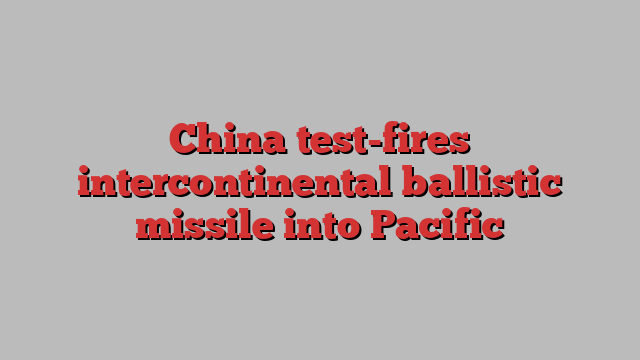
Unlock the Editor’s Digest for free
Roula Khalaf, Editor of the FT, selects her favourite stories in this weekly newsletter.
China fired an intercontinental ballistic missile into the Pacific Ocean on Wednesday in its first major missile launch since twin hypersonic weapons tests in the summer of 2021.
The test comes as the People’s Liberation Army is conducting intensive air and naval drills around the region ahead of a call between Chinese leader Xi Jinping and US President Joe Biden expected in the coming weeks.
The ICBM carrying a dummy warhead was launched into international waters at 8.44am, China’s defence ministry said, adding that it was a “routine arrangement in our annual training plan” in line with international law and not directed against any country or target.
But observers interpreted the launch as a political message and show of force, saying it could heighten concerns in the US and among China’s neighbours about Beijing’s modernisation of its nuclear weapons.
“They are signalling that China has the capability to hit US territory with nuclear weapons,” said Lin Ying-yu, a Taiwanese PLA expert. “This show of force could be intended to give them more bargaining power in the upcoming call between Xi and Biden.”
In July 2021, the PLA launched a rocket that used a “fractional orbital bombardment” system to propel a nuclear-capable “hypersonic glide vehicle” around the Earth for the first time. It held a second hypersonic test the next month.
Beijing did not specify which missile it tested on Wednesday.
“Most of the PLA’s ballistic missile firing training uses test ranges in Xinjiang or the Bohai Sea as target areas,” said Hsu Yen-chi, a researcher at the Council on Strategic and Wargaming Studies think-tank in Taipei. “It is very rare for them to use a range other than these two as an ICBM firing range, the last time being in 1980.”
Lin said the test could indicate the increasing maturity of China’s Beidou satellite navigation system, which the PLA uses for missile guidance.
He added that it could also reflect an effort by the Rocket Force, the PLA arm in charge of conventional and nuclear missile operations, to show that its combat power had not been weakened by Xi’s purges of the force’s leadership and an ongoing anti-corruption crackdown.
China, which in the past kept only a small number of nuclear warheads to allow it to retaliate against an enemy’s nuclear strike, is now engaged in a rapid expansion of its warhead and missile launcher arsenal.
This build-up could transform China into a peer of the US and Russia, the world’s two leading nuclear powers, by the early 2030s, according to US defence experts.
Beijing’s increasing nuclear strength and its opaque intentions have triggered a debate in Washington on whether and how the US needs to expand and adjust its own nuclear capabilities and posture.
China and the US started nuclear talks last year after a meeting between Xi and Biden, but China suspended them in July.
Last month, Beijing called for the UN Security Council’s permanent members to match its own “no first use” policy, in a move that attacked Washington’s nuclear sharing arrangements with Nato allies and nuclear umbrella protections in Asia.
Taiwan’s defence ministry said it had observed “recent intensive missile launch drills and other training activities” by the Chinese military.
For the first time, all three Chinese aircraft carriers were at sea simultaneously on Wednesday.
The Liaoning, the PLA’s first carrier, is conducting a training mission in the western Pacific, while the second carrier, the Shandong, is in the South China Sea, and China’s newest carrier, the Fujian, is undergoing sea trials.
According to Japan’s military, another PLA Navy flotilla entered the Sea of Okhotsk on Monday as Chinese and Russian naval ships trained together in the vicinity of Japan.
By conducting the ICBM test at the same time as the other drills, “the PLA is flexing their muscles with all-domain capabilities”, said James Chen, a professor at Tamkang University in Taipei.